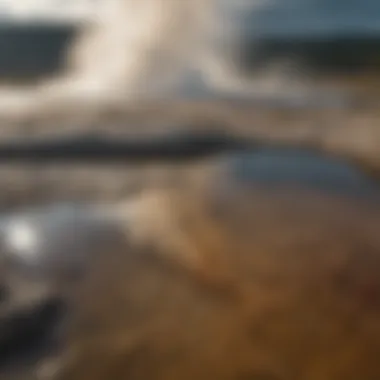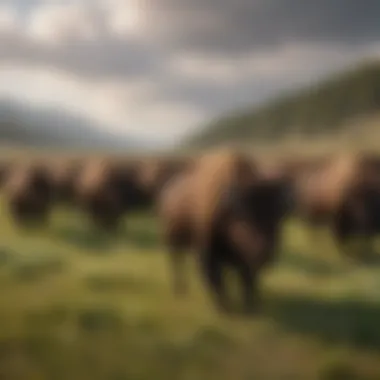Discover Yellowstone in June: A Complete Guide


Intro
June marks a pivotal time within Yellowstone National Park, transitioning from the snowy embrace of winter to a vibrant landscape brimming with life. Visitors are drawn to the park not only for its iconic beauty but for the opportunity to observe a diverse range of animal species in their natural habitats. This month offers a unique mix of activities for those who appreciate both outdoor adventures and the intricate workings of nature.
While roaming through the park, one can expect engaging encounters with various wildlife. From majestic bison to elusive wolves, each species contributes to Yellowstone's rich tapestry of ecosystems. Understanding these animals is crucial for visitors looking to maximize their experience.
The following sections delve deeper into the animal overview, exploring essential aspects like behavioral patterns, habitat interactions, and their roles within the ecosystem. Each facet will enhance the appreciation of the park’s wildlife during this dynamic period.
Animal Overview
Common Names
In Yellowstone, the landscape is alive with a variety of animal species. Some notable common names include:
- American Bison
- Grizzly Bear
- Elk
- Bald Eagle
- River Otter
Scientific Classification
A clear scientific classification of these animals helps to understand their biological importance:
- American Bison (Bison bison)
- Grizzly Bear (Ursus arctos horribilis)
- Elk (Cervus canadensis)
- Bald Eagle (Haliaeetus leucocephalus)
- River Otter (Lontra canadensis)
Geographic Range
The geographic range of these species typically overlaps within Yellowstone and its surrounding areas. The park serves as a vital sanctuary for their survival, especially as many face threats from habitat loss and climate change. Bison roam the plains, while bears thrive in the mountains. Elk often graze in the meadows, and eagles can be spotted soaring over lakes and rivers.
Prologue to Yellowstone National Park
Yellowstone National Park holds a unique position as America’s first national park, established in 1872. Its vast landscapes, diverse ecosystems, and distinctive geothermal features form a rich tapestry that beckons visitors from all over the world. Understanding Yellowstone's significance is crucial for anyone planning to visit, especially in June when the park comes alive with activity. This introduction sets the stage for appreciating what makes Yellowstone a remarkable destination.
Overview of Yellowstone's Geography
Yellowstone's geography is characterized by a remarkable blend of natural wonders. The park spans approximately 3,472 square miles, encompassing stunning mountain ranges, expansive valleys, and deep canyons. Its elevation varies widely, with peaks reaching over 11,000 feet in the Rocky Mountains. Inside the park, visitors will find the Yellowstone Lake, which is one of the largest high-elevation lakes in North America, and impressive waterfalls like the Lower Falls of the Yellowstone River.
Moreover, the park's position above a supervolcano creates a unique geological landscape filled with hot springs, geysers, and fumaroles. This geologically active area is emphasized by the presence of the well-known Old Faithful Geyser, which attracts countless nature enthusiasts keen to witness its eruptions. Understanding this geographical diversity enhances appreciation during a visit.
Historical Significance of Yellowstone
Yellowstone’s historical significance is not limited to its natural wonders. The park is a symbol of conservation and national heritage. As the first national park, it set a precedent for the establishment of protected areas in the United States and around the world. The visionary work of individuals like John Muir and Theodore Roosevelt played a pivotal role in its preservation.
Before it became a national park, the land was inhabited by various Native American tribes, including the Shoshone, Crow, and Nez Perce. Their rich cultural history adds depth to the overall experience of visiting Yellowstone. Additionally, understanding the archeological sites within the park, some dating back thousands of years, reveals the long-standing human connection to this extraordinary landscape.
In summary, learning about Yellowstone’s geography and history enriches the overall experience for visitors, especially during the vibrant month of June when its natural beauty is at its peak. Understanding these elements helps visitors cultivate a deeper appreciation for the park’s ecological and cultural importance.
Why June is an Ideal Time to Visit
June emerges as a prime month for experiencing Yellowstone National Park, underlining a unique blend of favorable conditions that appeal to a diverse range of visitors. As the park transitions from the snow-covered vista of late spring to the lush environment of summer, it presents an inviting opportunity for exploration and engagement with nature. This month serves not only as a gateway to warmer weather but also as the ideal backdrop for understanding the park's geographical and ecological dynamics.
Weather Conditions in June
In June, Yellowstone features relatively mild temperatures. Average daytime highs can reach around 70°F (21°C), while nighttime lows typically hover around 40°F (4°C). This combination creates a comfortable atmosphere for outdoor activities. Rainfall is moderate, so visitors may encounter brief showers, but they typically do not hinder exploration.
It is crucial to pack accordingly to adapt to these variable conditions. Layered clothing is recommended to accommodate the temperature shifts experienced throughout the day. A sturdy rain jacket can provide added comfort during unexpected rain.
Visitors should also be aware of the park's elevation, which can affect temperatures. The higher areas can still experience cooler weather even in June, particularly in the mornings and evenings. Being prepared will enhance the overall experience.


Floral and Faunal Activity
June is a vibrant month for both flora and fauna in Yellowstone. Wildlife becomes increasingly active, as many species are rearing young and foraging for food. Visitors can expect to see various animals, including bison, elk, and, with some luck, the elusive wolf. Each of these creatures plays a vital role in the ecosystem, and observing them can deepen one’s understanding of natural dynamics.
The lush greenery surfaces during this month, creating a picturesque landscape. Wildflowers start to bloom in diverse colors. Species such as lupine, columbine, and indian paintbrush offer a stunning visual treat while contributing to the park's biodiversity.
The sight of young wildlife in June can be particularly rewarding for nature enthusiasts and educators alike, providing unique learning opportunities.
Adjusting to this rhythm of life is vital for visitors seeking a comprehensive experience. Wildlife watchers should be patient, understanding that dawn and dusk often present the best opportunities for animal sightings. This immersive approach allows for greater appreciation of the intricate connections within the park’s ecosystem.
Outdoor Activities in Yellowstone
Outdoor activities in Yellowstone are central to the experience of visitors seeking to connect with the park's natural beauty. Engaging in these activities allows individuals to immerse themselves in breathtaking environments, witness diverse wildlife, and appreciate the geothermal phenomena unique to the area. From hiking to wildlife watching, the variety of options both energizes and educates those who venture into the park.
Hiking Trails to Explore
Popular Hiking Routes
Popular hiking routes in Yellowstone include pathways such as the Uncle Tom's Trail, Mount Washburn, and the Cascade Lake Trail. Each of these trails provides unique views and insights into the park's ecosystem. The Uncle Tom's Trail descends into the Grand Canyon of the Yellowstone, allowing hikers a close look at the power of the waterfalls. Mount Washburn offers panoramic views, where one can see various geothermal features and wildlife in their habitats.
Not only do these trails cater to various skill levels, but they also allow for exploration of flora and fauna along the way. Wildlife can often be seen on these routes, enriching the hiking experience. However, these routes can become crowded in June since many people visit during this time, so early starts are advisable.
One must remember to carry sufficient water and snacks. Moreover, being aware of wildlife, such as bears, is crucial for a safe hiking experience.
Hiking Safety Tips
Hiking safety tips are essential for ensuring a pleasant and secure outing. The landscape can be unpredictable, and conditions may change rapidly. Key aspects of hiking safety include understanding the terrain and weather conditions, traveling in groups, and informing someone about your plans. It's also advisable to carry a first-aid kit and know how to use it.
In Yellowstone, wildlife encounters are common but should be handled with caution. It's important to keep a safe distance from animals, regardless of their size. The park suggests remaining at least 100 yards away from bears and wolves and 25 yards away from other wildlife. Being prepared and educated about these encounters can enhance safety significantly.
Outdoor gear should also match the season. Layering is a smart choice in June as temperatures can vary. Remember to wear sturdy, durable footwear and check trail conditions before setting out.
Wildlife Watching Opportunities
Best Locations for Sightings
Best locations for wildlife sightings include Lamar Valley, Hayden Valley, and the areas surrounding Mammoth Hot Springs. These regions are known for high concentrations of different animal species. Leaving the main roads and venturing into more secluded areas often increases the chances of encountering animals like bison, elk, or even the elusive grizzly bear.
Visiting these locations provides not only thrills but also educates visitors about the wildlife that inhabits the region. Each area has its unique character; for instance, Lamar Valley is often referred to as the Serengeti of North America due to its large grazing herds and predator activity.
Recommended Time for Viewing
Recommended times for viewing wildlife in Yellowstone usually occur during dawn and dusk when animals are most active. These times are considered the best for spotting wildlife due to their natural behavior patterns. The morning hours present opportunities to observe animals as they emerge from resting areas, while evening offers chances for them to return as night approaches.
Planning visits during these times not only enhances the experience but also maximizes the likelihood of sightings. It is advisable to stay quiet and patient while watching wildlife; sudden movements can scare them away.
Overall, engaging in outdoor activities in Yellowstone in June can provide enriching experiences that satisfy both the body and the mind. As visitors explore hiking trails and search for wildlife, they forge a deeper connection to the majestic landscapes of the park.
Geothermal Wonders of Yellowstone
The geothermal features of Yellowstone National Park are not only visually stunning but also provide significant insights into geological processes. This park sits atop a supervolcano, which results in numerous geothermal phenomena. These features highlight the delicate balance in nature and represent a unique part of Earth's geology that attracts scientists, tourists, and educators alike. Exploring these geothermal wonders offers visitors an opportunity to engage with the natural world and its complexities, fulfilling both educational and recreational ambitions.
Must-See Geothermal Features
Old Faithful Geyser


Old Faithful Geyser is a prominent feature within Yellowstone National Park and is well-known for its predictable eruptions. Approximately every 90 minutes, it shoots a column of boiling water into the air, reaching heights of 100 to 180 feet. This key characteristic makes Old Faithful a popular destination for park visitors.
One advantage of visiting Old Faithful is the accessibility of the site. It is located near a main road, making it easy for families and visitors of varying abilities to witness the eruption. The predictability of the eruptions adds to its allure, allowing visitors to time their arrival effectively. However, the crowds can become significant during peak seasons. Thus, planning a visit during less crowded hours may enhance the experience. Old Faithful represents the reliability of nature’s power, reminding us of the Earth’s thermal activity.
Grand Prismatic Spring
Grand Prismatic Spring, often recognized as the colored jewel of Yellowstone, is the largest hot spring in the United States and the third largest in the world. Its vividly colored waters create a mesmerizing spectacle, with colors ranging from deep blue to bright orange. The unique colors result from heat-loving bacteria thriving in the warm waters, creating a living palette.
The key characteristic of Grand Prismatic Spring is its immense size, about 370 feet in diameter, making it a must-see for any visitor interested in geothermal wonders. Viewing platforms near the spring allow for up-close encounters, though it's crucial to maintain safe distances as the ground can be unstable in certain areas. While visiting offers many advantages, it is essential to be mindful of environmental impact, ensuring that we preserve these natural wonders for future generations.
Educational Aspects of Geothermal Activity
The geothermal activity in Yellowstone serves as a rich educational resource. Various visitor centers and ranger-led programs offer insights into the underlying science. For instance, the processes involved in the formation of geysers and hot springs can be explored through interactive exhibits that engage visitors of all ages.
Moreover, understanding the ecological impacts of geothermal features enhances the experience. These areas often house unique ecosystems that are adapted to extreme conditions. Learning about these organisms contributes to a broader understanding of biology and ecology.
Enhancing one's visit with educational resources not only deepens the appreciation for Yellowstone's natural environment but also fosters a sense of responsibility toward conservation efforts. Visitors leave not only with memories of breathtaking sights but also with knowledge that empowers them to advocate for the protection of these geothermal wonders.
Cultural and Educational Activities
Cultural and educational activities in Yellowstone National Park serve as a significant aspect of the visitor experience. They offer opportunities to understand the park's natural and historical context, which enriches the overall visit. Through these activities, guests can engage in learning while surrounded by majestic landscapes and diverse wildlife. We will discuss the visitor centers, museums, interactive exhibits, educational programs, and ranger-led activities that help make the experience both informative and memorable.
Visitor Centers and Museums
Interactive Exhibits
Interactive exhibits at Yellowstone's visitor centers create an engaging space for learning. These exhibits allow visitors to interact with various displays that explain the park's geology, ecology, and history. For example, visitors can touch exhibits that showcase different rock types or view models of geothermal features like geysers. The hands-on nature of these exhibits encourages curiosity and deeper understanding.
A key characteristic of interactive exhibits is their ability to captivate all age groups. Children, in particular, find them beneficial as they experience learning through play. The unique feature of these exhibits often lies in their immersive technology, including touchscreen panels or augmented reality. While they can be quite popular, it is essential to manage the visitor flow to avoid overcrowding, especially during peak season in June.
Educational Programs
Educational programs offered in Yellowstone provide a structured way for visitors to learn about the park. These programs cover a range of topics, such as wildlife behavior, ecosystem dynamics, and conservation principles. They are effective in bringing awareness to both the natural and human history of the area.
Programs are designed for different age groups and experience levels. Many programs include guided walks, workshops, and talks by knowledgeable park staff. A unique feature of these educational programs is their ability to take advantage of real-world environments. Participants often engage in hands-on learning, which leads to a more profound appreciation for the park's treasures. However, it is essential for visitors to sign up in advance as spaces may be limited, particularly in June when interest is high.
Ranger-Led Programs
Ranger-led programs provide a direct connection between guests and park staff. Rangers offer insights that can only come from trained professionals who understand Yellowstone’s ecosystems. Their experience allows them to share personal stories and data collected over the years, bringing the park to life.
These programs vary significantly. They may include guided hikes, wildlife tracking, or evening talks about stargazing. The structure and timing of these programs are generally flexible, accommodating various visitor schedules. Each session provides a unique opportunity for questioning and discussion, enhancing the visitor's experience with firsthand knowledge.
Overall, cultural and educational opportunities in Yellowstone not only inform but also inspire. They play a vital role in fostering a sense of stewardship among visitors and a deeper understanding of this iconic park.
Planning Your Visit
Planning your visit to Yellowstone in June is essential for an enjoyable experience. The park, with its vast landscapes and diverse ecosystems, attracts many visitors. Understanding the options for accommodation and transportation will enhance your stay. Each of these elements can greatly affect the quality of your time in the park.
Accommodations and Camping Options
Camping Sites
Camping in Yellowstone offers a unique way to immerse yourself in nature. The campgrounds are often surrounded by breathtaking views and provide a direct connection to the park's wildlife. Campgrounds such as Madison, Canyon, and Bridge Bay are popular choices. These sites are equipped with essential amenities. Visitors can enjoy the sights and sounds of the park's natural environment while sleeping under the stars. However, knowing that campsites fill quickly is important. Make reservations well in advance.
The key characteristic of these camping sites is the proximity to natural attractions. For example, many campsites are located near hiking trails or geothermal features. This benefit allows for easy access to explore the park fully. An advantage of camping is the opportunity to experience wildlife at dawn and dusk, times when animals are most active. On the other hand, these sites can be less comfortable than other options.


Lodging Information
For those who prefer a more comfortable stay, there are various lodging options available within and near the park. Hotels like Old Faithful Inn and Lake Yellowstone Hotel offer stunning views and convenient access to major attractions. Staying at these lodges can provide a restful experience after a day of exploration. Unique features include historic architecture and diverse dining options.
The benefit of these lodges is the combination of comfort and location. Guests can return to their rooms to relax before continuing their adventure the next day. However, accommodations within the park often come with a higher price tag and may require early booking. It is advisable to weigh the value of comfort against the costs involved.
Transportation within the Park
Understanding transportation options within Yellowstone is crucial for effective planning. The park's layout means that many attractions are spread out over vast distances. Personal vehicles are a common mode of transportation, offering the flexibility to travel on your schedule. But during peak times, the roads can get congested, leading to delays. An alternative is the Yellowstone National Park shuttle service. This option is useful for those who prefer not to drive.
For wildlife lovers and educators, engaging with park rangers provides insight into the best viewing spots. Use maps from resources like Wikipedia to determine routes and stops along the park's main roads. Ensuring you have proper maps and updates on road conditions will help navigate Yellowstone efficiently. Overall, proper planning regarding accommodations and transportation is essential for an enriching visit to Yellowstone.
Proper planning can significantly enhance your Yellowstone experience. Remember to book accommodations and familiarize yourself with transportation options.
Conservation Efforts in Yellowstone
Conservation efforts in Yellowstone are crucial for maintaining the park's unique ecosystems and preserving its natural beauty. As one of the oldest national parks in the United States, its rich biodiversity and stunning landscapes necessitate ongoing protection and care. The impact of human activity and changing climate conditions poses significant challenges. Therefore, understanding conservation initiatives not only enhances visitor experience but also fosters a sense of responsibility among guests.
Current Conservation Projects
Yellowstone National Park runs numerous conservation projects aimed at protecting native species and their habitats. These efforts include:
- Wolf Reintroduction Program: This project has significantly aided in restoring the balance of the ecosystem since wolves were reintroduced in 1995. The presence of wolves has led to healthier elk populations and rejuvenated plant life.
- Bison Management: Efforts focus on tracking and managing bison populations to mitigate their impact on the environment and prevent overgrazing.
- Aquatic Species Conservation: Protection of native fish species is crucial. Projects include habitat restoration and monitoring of water quality in rivers and streams.
- Invasive Species Control: Removing invasive plant species, like cheatgrass and thistle, helps protect native flora. Educational programs raise awareness about the importance of native plants.
These projects not only support biodiversity but also engage researchers, volunteers, and park staff in meaningful work.
Conservation is a shared responsibility. Visitors are crucial to protecting Yellowstone's legacy for future generations.
Visitor Responsibilities
As visitors to Yellowstone, embracing a sense of responsibility toward conservation is vital. Understanding and adhering to certain guidelines can greatly impact the preservation of this natural treasure:
- Stay on Designated Trails: Protecting fragile ecosystems is essential. Avoid trampling on vegetation or disturbing wildlife habitats.
- Do Not Feed Wildlife: Feeding animals can lead to dependency on human food, compromising their natural foraging behavior.
- Proper Waste Disposal: Always dispose of waste in designated bins to minimize pollution. Encourage others to do the same.
- Educate Yourself and Others: Knowledge is a powerful tool. Share information about conservation with friends and family.
Adopting responsible practices ensures that the natural wonders of Yellowstone remain unspoiled. By understanding their role as stewards of the park, visitors contribute to a sustainable ecosystem that can be enjoyed by generations to come.
Culmination and Final Thoughts
As one finishes their exploration of Yellowstone in June, it becomes clear that this park holds a wealth of experiences. The combination of vibrant wildlife, breathtaking geothermal features, and diverse ecosystems creates a multifaceted environment that captivates visitors. This is not merely a destination; it is a complex tapestry of nature's beauty and resilience.
Several key elements stand out when reflecting on a visit. The variety of activities available offers something for every type of traveler. From the thrill of hiking along established trails to the serene moments spent observing wildlife, each experience contributes to a deeper appreciation for the natural world.
Benefits of Visiting Yellowstone in June:
- Wildlife activity is at its peak, making sightings more frequent and varied.
- Weather tends to be mild, allowing for comfortable exploration.
- Blooming flora enhances the already scenic landscapes, adding color and fragrance.
It is also essential to consider some practical aspects. Visitors must be mindful of park regulations and the impact they have on the surrounding environment. Engaging in responsible tourism is crucial for the conservation of this delicate ecosystem.
"Yellowstone is not just a place to visit, but a pivotal learning moment about nature's mechanics and our role in it."
In reflection, a visit to Yellowstone in June should not just be seen as a getaway. Instead, it should be viewed as an opportunity for personal growth and education. Every interaction with this park can serve as a reminder of the need to respect and protect our natural heritage. Ultimately, the memories created within Yellowstone’s boundaries are invaluable and resonate long after the trip is over.
Reflecting on the Experience
When visitors leave Yellowstone, they often carry home more than just photographs. The experience of being enveloped by nature's grandeur invites introspection and appreciation. Many travelers mention a renewed sense of respect for wildlife. Watching animals in their natural habitat brings awareness to issues such as habitat loss and the importance of conservation efforts.
Moreover, the educational opportunities presented in the park, from ranger-led programs to interactive museum exhibits, enrich the journey. Engaging with knowledgeable staff and participating in discussions about ecology and preservation deepens understanding.
Key Takeaways:
- Experiencing nature fosters a connection that goes beyond surface-level enjoyment.
- Awareness of environmental issues grows through direct observation and learning.
- Travel can shift perspectives, making one more considerate of their impact on nature.







